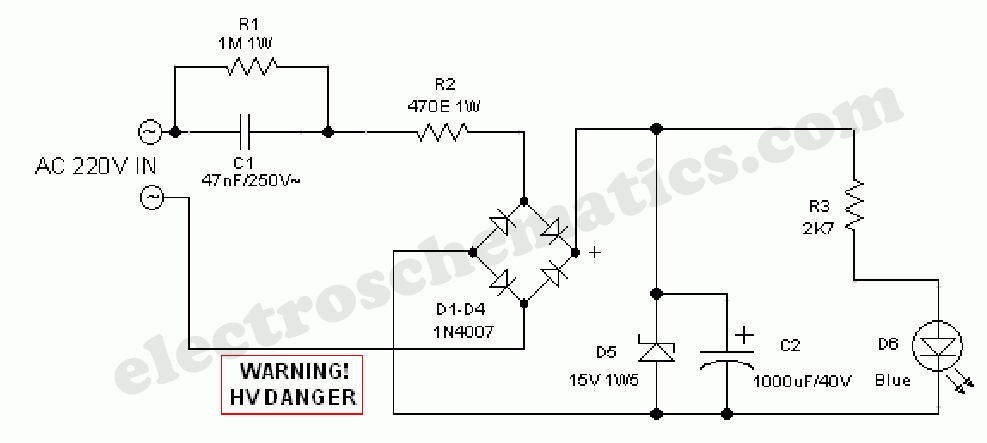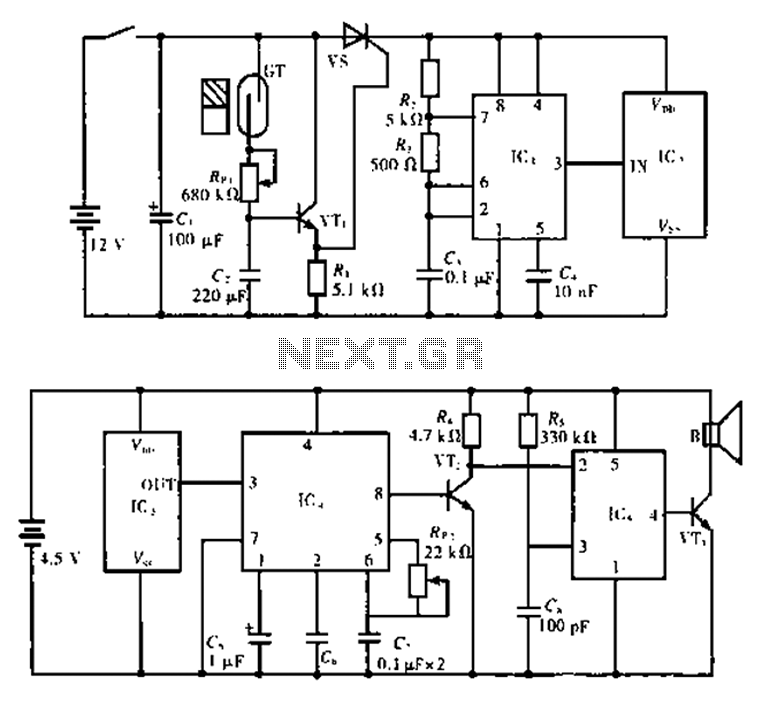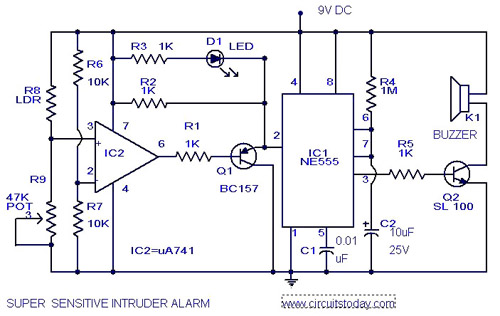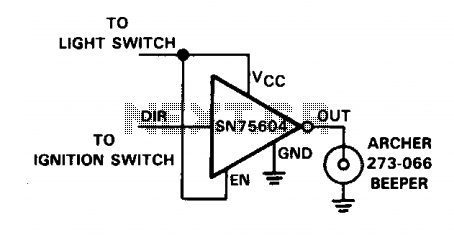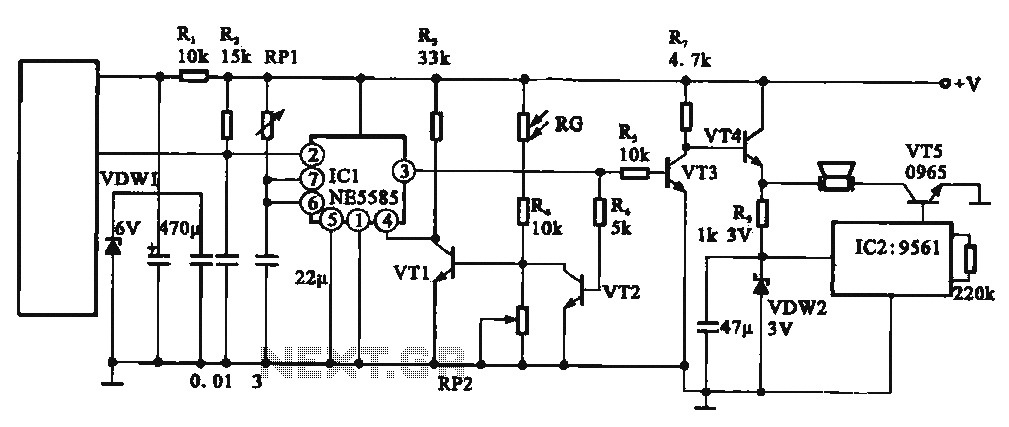
Car Wireless Alarm
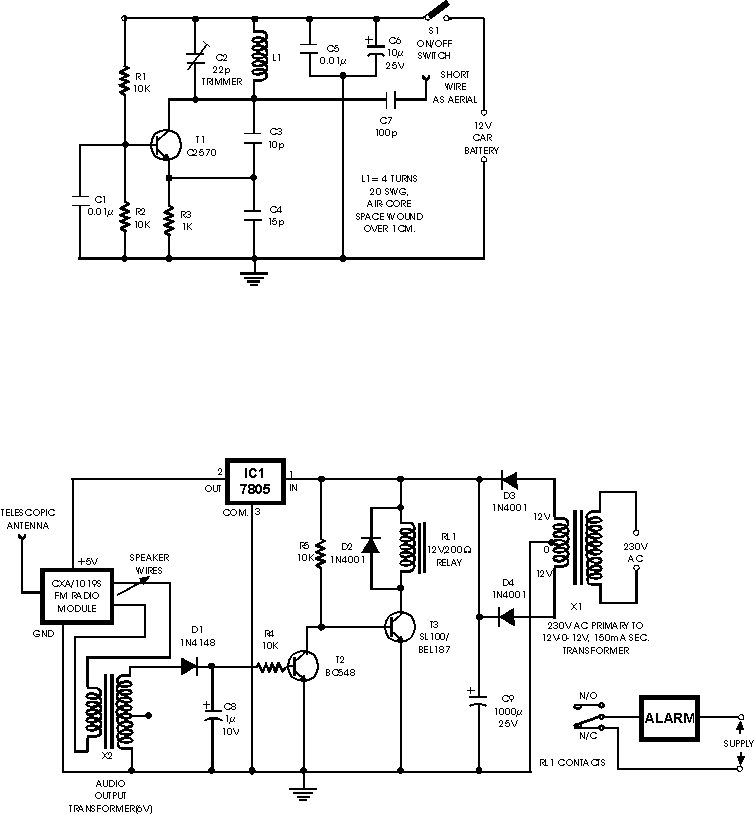
This FM radio-controlled anti-theft system can be used with any device operating on a 6 to 12-volt DC power supply. The mini VHF FM transmitter is installed in the vehicle at night when it is parked in the driveway or car park. The receiver unit, utilizing the CXA1019, a single IC-based FM radio module, is conveniently available in the market at a reasonable price. The receiver is tuned to the transmitter's frequency. When the transmitter is active and signals are being received by the FM radio receiver, no hissing noise is present at the receiver's output. Consequently, transistor T2 (BC548) remains non-conductive. This results in the broadcast driver transistor T3 having its base pulled high through a 10k resistor (R5), and the broadcast is energized. If an intruder attempts to drive the car and moves it a few meters away from the parking area, the radio link between the car (transmitter) and the receiver is interrupted. As a result, the FM radio output generates hissing noise. These hissing AC signals are fed into the broadcast switching circuit via an audio transformer. The AC signals are rectified and filtered by diode D1 and capacitor C8, and the resulting positive DC voltage provides a high base voltage to transistor T2. Consequently, transistor T2 conducts, pulling the base of the broadcast driver transistor T3 to ground level. This deactivates the broadcast, and the alarm connected via the normally closed (N/C) contacts of the broadcast is triggered. If, by chance, the intruder disconnects the transmitter from the battery, the external alarm remains active because, in the absence of the signal, the receiver continues to produce hissing noise at its output. Thus, the alarm system is robust and highly reliable.
The FM radio-controlled anti-theft system operates on a fundamental principle of radio frequency communication and signal detection. The transmitter, designed to operate in the VHF band, is integrated into the vehicle, ensuring it remains concealed and protected from tampering. It is powered by a 6 to 12-volt DC supply, which is commonly available in most vehicles. The CXA1019 receiver module is a compact and efficient IC that is specifically tuned to the frequency of the transmitter, allowing for reliable communication.
The system's functionality hinges on the relationship between the transmitter and receiver. When the vehicle is parked, the transmitter continuously sends a signal to the receiver. Under normal conditions, the absence of interference ensures that transistor T2 remains off, and the main alarm system remains inactive. However, this changes when an unauthorized attempt to move the vehicle occurs. The interruption of the radio frequency link triggers a sequence of events that leads to the activation of the alarm.
The audio transformer plays a crucial role in converting the hissing noise generated by the receiver into a form that can be processed by the alarm circuitry. The rectification and filtering stages, performed by diode D1 and capacitor C8, ensure that the signal is transformed into a stable DC voltage that can effectively control transistor T2. The design of the circuit allows for quick response to unauthorized movement, ensuring that the alarm is triggered promptly.
Furthermore, the system's resilience is highlighted by its ability to remain functional even if the transmitter is disconnected. The continuous generation of hissing noise by the receiver serves as a fail-safe mechanism, ensuring that the alarm remains active and provides a reliable deterrent against theft. Overall, this FM radio-controlled anti-theft system represents a sophisticated approach to vehicle security, combining ease of installation with effective protection against unauthorized access.This FM radio-controlled anti- annexation anxiety can be acclimated with any agent accepting 6- to 12-volt DC accumulation system. The mini VHF, FM transmitteris adapted in the agent at night back it is anchored in the car balustrade orcar park.
The receiver assemblage with CXA1019, a distinct IC-based FM radio module, which is advisedly accessible in the bazaar at reasonable rate, is kept inside. Receiver is acquainted to the transmitter`s frequency. Back the transmitter is on and the signals are actuality accustomed by FM radio receiver, no hissing babble is accessible at the achievement of receiver. Appropriately transistor T2 (BC548) does not conduct. This after-effects in the broadcast disciplinarian transistor T3 accepting its advanced abject bent via 10k resistorR5 and the broadcast gets energised.
Back an burglar tries to drive the car and takes it a few metres abroad from the car porch, the radio articulation amid the car (transmitter) and anxiety (receiver) is broken. As a aftereffect FM radio bore gene-rates hissing noise. Hissing AC signals are accompanying to broadcast switching circ- uit via audio transformer. These AC signals are rectified and filtered by diode D1 and capacitor C8, and the consistent absolute DC voltage provides a advanced bent to transistor T2.
Appropriately transistor T2 conducts, and it pulls the abject of broadcast disciplinarian transistor T3 to arena level. The broadcast appropriately gets de-activated and the anxiety affiliated via N/C contacts of broadcast is switched on.
If, by chance, the burglar finds out about the wireless anxiety and disconnects the transmitter from battery, still alien anxiety charcoal activated because in the absence of signal, the receiver continues to aftermath hissing babble at its output. So the burglar anxiety is fool-proof and awful reliable. 🔗 External reference
The FM radio-controlled anti-theft system operates on a fundamental principle of radio frequency communication and signal detection. The transmitter, designed to operate in the VHF band, is integrated into the vehicle, ensuring it remains concealed and protected from tampering. It is powered by a 6 to 12-volt DC supply, which is commonly available in most vehicles. The CXA1019 receiver module is a compact and efficient IC that is specifically tuned to the frequency of the transmitter, allowing for reliable communication.
The system's functionality hinges on the relationship between the transmitter and receiver. When the vehicle is parked, the transmitter continuously sends a signal to the receiver. Under normal conditions, the absence of interference ensures that transistor T2 remains off, and the main alarm system remains inactive. However, this changes when an unauthorized attempt to move the vehicle occurs. The interruption of the radio frequency link triggers a sequence of events that leads to the activation of the alarm.
The audio transformer plays a crucial role in converting the hissing noise generated by the receiver into a form that can be processed by the alarm circuitry. The rectification and filtering stages, performed by diode D1 and capacitor C8, ensure that the signal is transformed into a stable DC voltage that can effectively control transistor T2. The design of the circuit allows for quick response to unauthorized movement, ensuring that the alarm is triggered promptly.
Furthermore, the system's resilience is highlighted by its ability to remain functional even if the transmitter is disconnected. The continuous generation of hissing noise by the receiver serves as a fail-safe mechanism, ensuring that the alarm remains active and provides a reliable deterrent against theft. Overall, this FM radio-controlled anti-theft system represents a sophisticated approach to vehicle security, combining ease of installation with effective protection against unauthorized access.This FM radio-controlled anti- annexation anxiety can be acclimated with any agent accepting 6- to 12-volt DC accumulation system. The mini VHF, FM transmitteris adapted in the agent at night back it is anchored in the car balustrade orcar park.
The receiver assemblage with CXA1019, a distinct IC-based FM radio module, which is advisedly accessible in the bazaar at reasonable rate, is kept inside. Receiver is acquainted to the transmitter`s frequency. Back the transmitter is on and the signals are actuality accustomed by FM radio receiver, no hissing babble is accessible at the achievement of receiver. Appropriately transistor T2 (BC548) does not conduct. This after-effects in the broadcast disciplinarian transistor T3 accepting its advanced abject bent via 10k resistorR5 and the broadcast gets energised.
Back an burglar tries to drive the car and takes it a few metres abroad from the car porch, the radio articulation amid the car (transmitter) and anxiety (receiver) is broken. As a aftereffect FM radio bore gene-rates hissing noise. Hissing AC signals are accompanying to broadcast switching circ- uit via audio transformer. These AC signals are rectified and filtered by diode D1 and capacitor C8, and the consistent absolute DC voltage provides a advanced bent to transistor T2.
Appropriately transistor T2 conducts, and it pulls the abject of broadcast disciplinarian transistor T3 to arena level. The broadcast appropriately gets de-activated and the anxiety affiliated via N/C contacts of broadcast is switched on.
If, by chance, the burglar finds out about the wireless anxiety and disconnects the transmitter from battery, still alien anxiety charcoal activated because in the absence of signal, the receiver continues to aftermath hissing babble at its output. So the burglar anxiety is fool-proof and awful reliable. 🔗 External reference
Warning: include(partials/cookie-banner.php): Failed to open stream: Permission denied in /var/www/html/nextgr/view-circuit.php on line 713
Warning: include(): Failed opening 'partials/cookie-banner.php' for inclusion (include_path='.:/usr/share/php') in /var/www/html/nextgr/view-circuit.php on line 713
